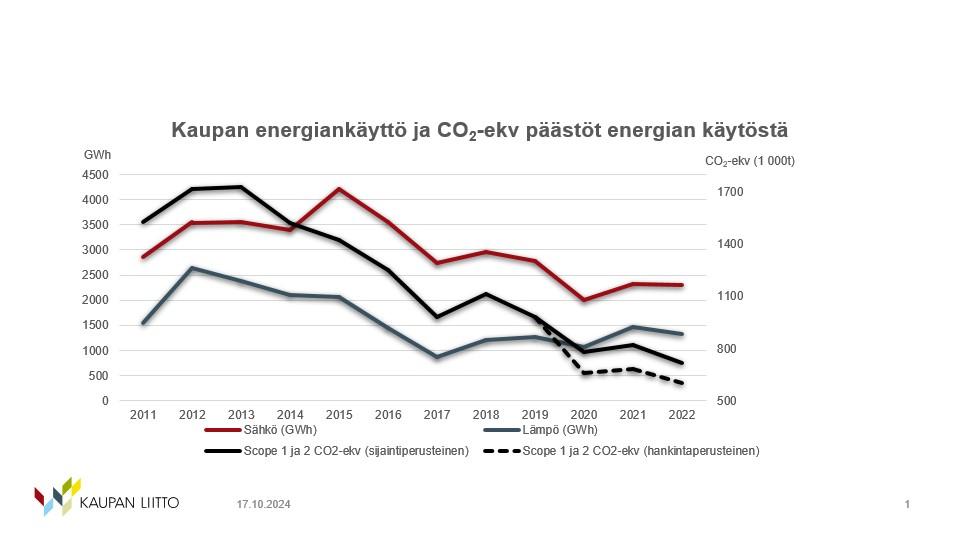Energy consumption and emissions in the commerce sector are decreasing effectively, but achieving the targets requires political decisions
In 2022, companies in the commerce sector reduced their electricity consumption by one per cent and their heat consumption by 9 per cent compared to 2021, says Statistics Finland. According to the carbon index for commerce, the sector’s CO2 emissions decreased by 12.3 per cent at the same time. Commerce’s goal is to achieve carbon neutrality by 2035 and zero emissions by 2050, but achieving these goals requires policy measures that support the sector.
For years, operators in the commerce sector have set and achieved ambitious targets for reducing energy consumption and carbon dioxide emissions. According to the statistics on energy accounts published by Statistics Finland, the consumption of electricity and heat by companies in the commerce sector decreased in 2022 compared to the previous year. Electricity consumption was 2,294 GWh, which is one per cent less than in 2021. Heat consumption was 1,324 GWh, meaning a reduction of 9 per cent compared to the previous year. According to Statistics Finland, Finns’ total energy consumption decreased by a total of 4 per cent in 2022.
“Commerce has been carrying out its energy efficiency work and reducing emissions systematically for several years. We have returned to a declining curve in electricity and heat consumption statistics, as the figures increased temporarily in 2021. However, this was due to the comparison of the figures with the coronavirus year 2020, when energy consumption generally decreased,” says Lauri Leskinen, Chief Policy Adviser of the Finnish Commerce Federation.
For the third time, the commerce sector has determined market-based greenhouse gas emissions of energy, which take into account the renewable and emission-free electrical and thermal energy of purchased energy. These emissions were reduced by 12 per cent compared to 2021. Based on location, i.e. based on the situation of the regional energy network, greenhouse gas emissions from energy use in the commerce sector decreased by 13 per cent in 2022. This figure is obtained by using state-specific average emission factors for energy production.

Reducing emissions in the future requires clear decisions
The commerce sector is committed to reducing energy use and emissions. For example, the 21 retail companies and more than 2,700 retail outlets participating in Motiva’s voluntary Energy Efficiency Agreement reached the joint energy savings target already in 2019, well before the original target year of 2025. In 2017–2023, the retail companies participating in the agreement have taken no less than 5,900 measures to promote energy efficiency.
In order for the reduction of energy use and emissions to continue to be effective, the Energy Performance of Buildings Directive and national legislation, for example, should focus on measures that genuinely reduce emissions.
“The renovation requirements of buildings must not lead to unnecessary renovations that are inefficient in terms of reducing emissions. The current directive includes, for example, the requirement to build some of the parking spaces in the property so that they can be equipped with an electric car charging point. In that case, the property may not be able to implement other, possibly more efficient energy-saving solutions,” Leskinen says.
The commerce sector aims to be carbon neutral by 2035 and nearly emission-free by 2050. According to the commerce sector’s low-carbon roadmap which was updated last summer, the commerce sector’s emissions as a whole in 2022 amounted to approximately 28.3 million tonnes of carbon dioxide equivalent (MtCO2e), of which the share of the daily consumer goods trade was 54 per cent, the share of the specialty goods trade 36 per cent and the share of the technical trade 10 per cent. Almost 98 per cent of the total emissions were generated in the value chains of companies in the sector.
According to the Finnish Commerce Federation, achieving carbon neutrality by 2035 and zero emissions by 2050 requires cooperation between many different operators, but also policy measures targeted at the sector, such as:
- Creating a separate tax category for the service sectors in the electricity tax rate. The electricity tax the service sector pays is over 40 times more expensive than that of the industrial sector.
- Supporting self-sufficient electricity generation and raising the lower limit for small-scale generation. This encourages the construction of local solar and wind power, among other things.
- Using waste heat from the commerce sector more extensively than currently (two-way district heating).
- Creating incentive support mechanisms for low-carbon investments.
The carbon index monitors the development of emissions in the commerce sector
The carbon index for commerce was created as part of the Renewable Commerce 2035 roadmap published in June 2020 to monitor the scenarios presented in it. The index is part of the implementation of the low-carbon roadmap work. We will report on the development of the carbon index annually in the autumn, after Statistics Finland has published its statistics on atmospheric emissions and energy accounts.
Monitoring the carbon index allows us to compare real emissions figures to two of the scenarios presented in the roadmap – the basic track and the track of renewable commerce – while assessing the impact of policy and corporate measures on reducing emissions in practice.
The commerce sector’s carbon index is based on comprehensive information about the direct and indirect emissions in commerce, such as the use of electricity and heat, collected from various official sources. In addition, emissions from market-based purchased energy have been taken into account since 2020. Companies in the commerce sector that are committed to the Science Based Targets (SBTi)* and whose emissions data are publicly available have been included.
Other data include the present emissions factors produced by Finnish Energy, and they have been used to harmonise the future factors for different scenarios and their impacts on the sector.
*The Science Based Targets initiative (SBTi) has been created to promote climate action in the private sector, helping companies set science-based emission reduction targets for their own operations. The initiative sets out clear policies for companies to reduce greenhouse gas emissions.
The update of the carbon index for commerce has been carried out in cooperation with ToDD’s Satu Pahkala. Graphics: Satu Pahkala/ToDD
For further information, please contact: Lauri Leskinen, Chief Policy Adviser, Finnish Commerce Federation, tel. +358 44 091 1067, lauri.leskinen(at)tekninen.fi



